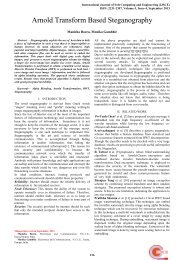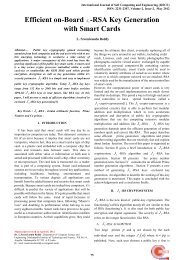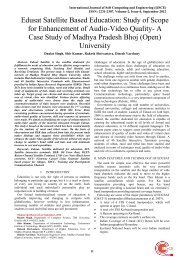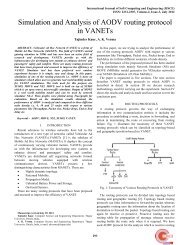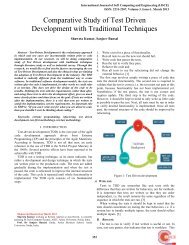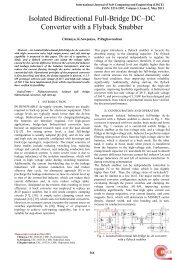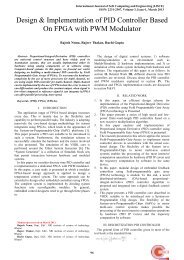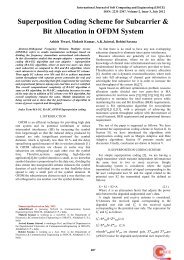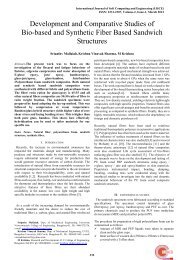A Parametric Study on Impedance Matching of A CPW Fed T ...
A Parametric Study on Impedance Matching of A CPW Fed T ...
A Parametric Study on Impedance Matching of A CPW Fed T ...
You also want an ePaper? Increase the reach of your titles
YUMPU automatically turns print PDFs into web optimized ePapers that Google loves.
Internati<strong>on</strong>al Journal <strong>of</strong> S<strong>of</strong>t Computing and Engineering (IJSCE)<br />
ISSN: 2231-2307, Volume-2, Issue-2, May 2012<br />
A <str<strong>on</strong>g>Parametric</str<strong>on</strong>g> <str<strong>on</strong>g>Study</str<strong>on</strong>g> <strong>on</strong> <strong>Impedance</strong> <strong>Matching</strong><br />
<strong>of</strong> A <strong>CPW</strong> <strong>Fed</strong> T-shaped UWB Antenna<br />
D.Ujwala, D.S.Ram Kiran, B.Jyothi, Shaik Saira Fathima, P.Harish, Y.M.S.R.Koushik<br />
Abstract:- A <strong>CPW</strong> fed novel compact Ultra wide band<br />
antenna is proposed in this paper. The size <strong>of</strong> the antenna<br />
is 20mm x 20mm x 0.6mm and it is prototyped <strong>on</strong> FR4-<br />
Epoxy substrate material which has a dielectric c<strong>on</strong>stant <strong>of</strong><br />
4.4. The proposed antenna provides a bandwidth <strong>of</strong> 5.45<br />
GHz from 4.76 GHz to 10.21 GHz which can be used for<br />
wireless applicati<strong>on</strong>s. A parametric study is carried out by<br />
varying the horiz<strong>on</strong>tal and vertical gaps ‘g’ and ‘d’<br />
between the c<strong>on</strong>ducting patch and ground. The output<br />
parameters and the dimensi<strong>on</strong>al variati<strong>on</strong> effects <strong>on</strong> the<br />
proposed antenna are presented in this paper. Simulati<strong>on</strong>s<br />
are carried out using Finite Element based Ans<strong>of</strong>t High<br />
Frequency Structure Simulator.<br />
Index Terms:- <strong>CPW</strong> fed, Ultra Wide band, Wireless<br />
applicati<strong>on</strong>s.<br />
I. INTRODUCTION<br />
As high data rate wireless communicati<strong>on</strong> technologies<br />
are gaining importance in modern communicati<strong>on</strong> systems,<br />
design <strong>of</strong> an antenna with compact size, simple structure and<br />
wide operating frequency range is a challenge. Ultra wide<br />
band systems provide wide bandwidth with high data<br />
transfer rates and less multi path interference. In 2002,<br />
<strong>Fed</strong>eral Communicati<strong>on</strong> Commissi<strong>on</strong> allocated a band range<br />
from 3.1GHz to 10.6 GHz for UWB systems. Different<br />
varieties <strong>of</strong> printed slot antennas like L-shaped slot, inverted<br />
T-shaped slot etc., [1-2] are used for UWB applicati<strong>on</strong>s but<br />
they are larger in size. Antenna with parasitic elements [3]<br />
also increase the bandwidth but at the cost <strong>of</strong> size. Planar<br />
m<strong>on</strong>opole antennas provide wide band with small size [4-5].<br />
There are two different feeding techniques to excite UWB<br />
antennas. Microstrip line feed [6] or <strong>CPW</strong> [7-8] feed provide<br />
wide band operati<strong>on</strong> but <strong>CPW</strong> has more advantages like ease<br />
<strong>of</strong> integrati<strong>on</strong> with m<strong>on</strong>olithic Integrated circuits, Low<br />
dispersi<strong>on</strong> loss, less radiati<strong>on</strong> leakage and low pr<strong>of</strong>ile. In this<br />
paper, a miniature <strong>CPW</strong> fed T-Shaped Ultra wide band<br />
antenna prototyped <strong>on</strong> FR4-Epoxy substrate for wireless<br />
applicati<strong>on</strong>s is proposed. The antenna geometry is presented<br />
in secti<strong>on</strong> II. A brief discussi<strong>on</strong> <strong>on</strong> the simulati<strong>on</strong> results and<br />
parametric study is presented in secti<strong>on</strong> III. Gist <strong>of</strong> the paper<br />
is presented in secti<strong>on</strong> IV.<br />
Manuscript received ONApril 26, 2012.<br />
D.Ujwala, M.Tech, Communicati<strong>on</strong> and Radar Systems, Department<br />
<strong>of</strong> ECE, KLUniversity.<br />
D.S.Ram Kiran, Associate Pr<strong>of</strong>essor, Department <strong>of</strong> ECE,<br />
KLUniversity.<br />
Shaik Saira Fathima, P.Harish, Y.M.S.R.Koushik, B.Tech,<br />
Department <strong>of</strong> ECE, KLUniversity.<br />
433<br />
II. UWB ANTENNA GEOMETRY<br />
A novel <strong>CPW</strong> fed T-Shaped UWB antenna c<strong>on</strong>figurati<strong>on</strong><br />
is shown in Figure 1. The antenna is designed <strong>on</strong> FR4<br />
substrate <strong>of</strong> dielectric c<strong>on</strong>stant 4.4 and a thickness <strong>of</strong> 0.6mm.<br />
Figure 1: Proposed antenna Geometry<br />
The antenna is fed by Coplanar Waveguide (<strong>CPW</strong>) line <strong>of</strong><br />
input impedance 50 Ω. The antenna has a compact size <strong>of</strong><br />
20mm x 20mm x 0.6mm. A rectangular slot <strong>of</strong> size 15mm x<br />
10mm is made in the ground. A T-Shaped patch is<br />
c<strong>on</strong>structed with the dimensi<strong>on</strong>s as shown in figure. A<br />
parametric study is carried out by varying the parameters „g‟<br />
and „d‟. The proposed antenna res<strong>on</strong>ates at three frequencies<br />
for the given dimensi<strong>on</strong>s. The res<strong>on</strong>ant frequency variati<strong>on</strong>s,<br />
bandwidth and the impedance matching dependence <strong>of</strong> the<br />
antenna <strong>on</strong> the gap between the <strong>CPW</strong> feed line and ground<br />
are presented in this paper. Finite Element Method based<br />
Ans<strong>of</strong>t HFSS is used to analyze the antenna.<br />
III. RESULTS AND DISCUSSIONS<br />
A. Return Loss<br />
The three res<strong>on</strong>ant frequencies <strong>of</strong> the proposed antenna<br />
are 5.56 GHz, 8.44 GHz and 9.67 GHz. The operating<br />
frequency range is from 4.76 GHz to 10.21 GHz with a<br />
bandwidth <strong>of</strong> 5.45 GHz. The Return Loss values at the<br />
res<strong>on</strong>ant frequencies are -17.6 dB, -33.1 dB and -19.1 dB<br />
and the return loss plot is shown in figure 2.
dB(St(1,1))<br />
0.00<br />
-10.00<br />
-20.00<br />
-30.00<br />
A <str<strong>on</strong>g>Parametric</str<strong>on</strong>g> <str<strong>on</strong>g>Study</str<strong>on</strong>g> <strong>on</strong> <strong>Impedance</strong> <strong>Matching</strong> <strong>of</strong> A <strong>CPW</strong> <strong>Fed</strong> T -shaped UWB Antenna<br />
Name X Y<br />
m3<br />
Return Loss T-Shaped UWB Antenna ANSOFT<br />
m1 m2<br />
m1 4.7610 -10.0074<br />
m2 10.2070 -10.0087<br />
m3 5.5556 -17.5510<br />
m4 8.4444 -33.0553<br />
m5 9.6667 -19.0483<br />
-40.00<br />
4.00 5.00 6.00 7.00 8.00<br />
Freq [GHz]<br />
9.00 10.00 11.00<br />
m4<br />
m5<br />
Curve Info<br />
dB(St(1,1))<br />
Setup1 : Sweep1<br />
Figure 2: Return Loss vs Frequency<br />
The gap „g‟ between the <strong>CPW</strong> feed line and ground is<br />
varied and the variati<strong>on</strong> in impedance matching which<br />
effects the bandwidth and res<strong>on</strong>ant frequencies is observed<br />
in figure 3.<br />
Figure 3: Return Loss versus Frequency for g=0.1mm,<br />
0.3mm, 0.5mm<br />
For different gaps g=0.1mm, 0.3mm, 0.5mm, wide<br />
operating band is obtained for g=0.3mm which shows that<br />
there is a perfect impedance matching for g=0.3mm. For<br />
g=0.5mm, there is better impedance matching but the<br />
bandwidth is less than the <strong>on</strong>e obtained for g=0.3mm. For<br />
g=0.1mm, the antenna res<strong>on</strong>ated at two frequencies which<br />
can be used for dual band applicati<strong>on</strong>s rather than Ultra wide<br />
band applicati<strong>on</strong>s.<br />
Figure 4: Return Loss versus Frequency for d=1mm,<br />
2mm, 3mm, 4mm<br />
434<br />
Another parametric study is d<strong>on</strong>e by varying the height <strong>of</strong><br />
the T-shaped patch as a functi<strong>on</strong> <strong>of</strong> „d‟. For d=1mm, 2mm,<br />
3mm, 4mm, the variati<strong>on</strong> in return loss is shown in figure 4.<br />
There is a perfect impedance matching at d=3mm. For<br />
d=2mm, the bandwidth is reduced and less impedance<br />
matching is observed. For d=1mm, the return loss is above -<br />
10dB which doesn‟t meet the standard c<strong>on</strong>diti<strong>on</strong>s. For<br />
d=4mm, the antenna is used for dual band operati<strong>on</strong> rather<br />
than UWB applicati<strong>on</strong>s.<br />
B. VSWR<br />
Voltage standing wave ratio VSWR which is a functi<strong>on</strong> <strong>of</strong><br />
reflecti<strong>on</strong> coefficient represents the amount <strong>of</strong> power<br />
reflected from the antenna.<br />
VSWRt(Patch_T1)<br />
8.00<br />
7.00<br />
6.00<br />
5.00<br />
4.00<br />
3.00<br />
2.00<br />
1.00<br />
Name X Y<br />
m1 4.7600 1.9312<br />
m2 10.2100 1.9373<br />
m3 5.4500 1.3164<br />
m4 8.4400 1.0463<br />
m5 9.6700 1.2518<br />
VSWR T-Shaped UWB Antenna ANSOFT<br />
m1 m2<br />
m3<br />
0.00<br />
4.00 5.00 6.00 7.00 8.00 9.00 10.00 11.00<br />
Freq [GHz]<br />
Figure 5: VSWR vs Frequency<br />
m4<br />
m5<br />
Curve Info<br />
VSWRt(Patch_T1)<br />
Setup1 : Sw eep1<br />
An antenna is c<strong>on</strong>sidered to be perfectly matched when<br />
the VSWR value is between 1and 2. Figure 5 shows the<br />
VSWR plot versus frequency. It is observed that VSWR is<br />
between 1 and 2 in the entire operating range from 4.76 GHz<br />
to 10.21 GHz. The VSWR values at the three res<strong>on</strong>ant<br />
frequencies are 1.32, 1.05 and 1.25.<br />
C. Input <strong>Impedance</strong><br />
The impedance bandwidth for the proposed antenna is<br />
72.81% in the operating range 4.76 GHz to 10.21 GHz and<br />
the formula to calculate the impedance bandwidth is as<br />
shown in the formula.<br />
Where IPW=<strong>Impedance</strong> Bandwidth (in %)<br />
UF=Upper Frequency (GHz)<br />
LF=Lower Frequency (GHz)<br />
The input impedance smith chart is shown in figure 6.
D. GAIN<br />
Figure 6: Input <strong>Impedance</strong><br />
The gain <strong>of</strong> an antenna represents the amount <strong>of</strong> power<br />
transmitted in the directi<strong>on</strong> <strong>of</strong> peak radiati<strong>on</strong> to that <strong>of</strong> an<br />
isotropic source. It can be as high as 40-50 dBi for very large<br />
dish antennas and can be as low as 1.8 dBi for real antennas.<br />
Theoretically, it can never be less than 0dBi. The gain <strong>of</strong> the<br />
proposed antenna varies from 2.8 dBi to 5.4 dBi. The peak<br />
gain <strong>of</strong> the proposed antenna is 5.4 dBi at 9GHz. The gain<br />
versus frequency plot is shown in figure 7.<br />
E. Radiati<strong>on</strong> Patterns<br />
Figure 7: Gain vs Frequency<br />
The E-Plane plane radiati<strong>on</strong> patterns at the three res<strong>on</strong>ant<br />
frequencies for Phi=0 degrees and Phi=90 degrees are shown<br />
in figure 8.<br />
Figure 8: E-Plane Radiati<strong>on</strong> Patterns at 5.56 GHz, 8.44<br />
GHz and 9.67 GHz<br />
Internati<strong>on</strong>al Journal <strong>of</strong> S<strong>of</strong>t Computing and Engineering (IJSCE)<br />
ISSN: 2231-2307, Volume-2, Issue-2, May 2012<br />
435<br />
The H-plane radiati<strong>on</strong> patterns for Theta=0 degrees and<br />
Theta=90 degrees at the three res<strong>on</strong>ant frequencies is shown<br />
figure 9.<br />
Figure 9: H-Plane Radiati<strong>on</strong> Patterns at 5.56 GHz, 8.44<br />
GHz and 9.67 GHz<br />
The overall Radiati<strong>on</strong> Efficiency <strong>of</strong> the proposed antenna<br />
is obtained as 99% which is a good characteristic.<br />
IV. CONCLUSION<br />
A novel <strong>CPW</strong> fed T-shaped UWB antenna is proposed for<br />
wireless applicati<strong>on</strong>s. It has a compact size <strong>of</strong> 20mm x<br />
20mm x 0.6mm prototyped <strong>on</strong> FR4-Epoxy substrate. The<br />
proposed antenna has a wide operating range from 4.76 GHz<br />
to 10.21 GHz with a bandwidth <strong>of</strong> 5.45 GHz. The impedance<br />
bandwidth is achieved as 72.81% with a desirable<br />
impedance matching. A parametric study is performed <strong>on</strong><br />
impedance matching by varying the gap between the feed<br />
line and ground as well as by varying the height <strong>of</strong> the patch<br />
from the ground. The radiati<strong>on</strong> patterns are almost stable<br />
with good radiati<strong>on</strong> efficiency. The peak gain <strong>of</strong> the antenna<br />
is 5.4 dBi in the operating range.<br />
V. ACKNOWLEDGMENT<br />
The authors would like to express their gratitude towards<br />
the faculty <strong>of</strong> the ECE department, KLUniversity.<br />
REFERENCES<br />
[1] J.Y. Jan and J.-W. Su, “Bandwidth enhancement <strong>of</strong> a printed wide-slot<br />
antenna with a rotated slot,” IEEE Trans. Antennas Propag., vol. 53,<br />
no. 6, pp. 2111–2114, Jun. 2005.<br />
[2] S.I.Latif, L.Shafai, and S. K. Sharma, “Bandwidth enhancement and size<br />
reducti<strong>on</strong> <strong>of</strong> microstrip slot antennas,” IEEE Trans. Antennas Propag.,<br />
vol. 53, no. 3, pp. 994–1003, Mar. 2005.<br />
[3] K. H Kim, Y. J .Cho, S.H Hwang. S. O. Park, “Band notched UWB<br />
planar m<strong>on</strong>opole antenna with two parasitics,” Electr<strong>on</strong>. Lett., vol. 41,<br />
No 14, pp. 783-785, Jul. 2005.<br />
[4] Y. J . Cho, K. H. Kim, D. H choi, S. S. Lee and S. O. Park, “A miniature<br />
UWB planar m<strong>on</strong>opole antenna with 5-GHz band rejecti<strong>on</strong>filter and<br />
time domain characteristics,” IEEE trans. Antennas Propag., vol.54,<br />
pp. 1453-1460, Mar. 2006.<br />
[5] W. S. Lee, D. Z. Kim, K. J. Kim and Y. W. Yu, “Wideband planar<br />
m<strong>on</strong>opole antenna with dual band–notched characteristics”, IEEE<br />
trans. Antennas Propag., vol.54, no. 6, pp. 2800-2806, Jun. 2006.<br />
[6]Jen-Yea Jan, Liang-Chih Tseng, "Small Planar M<strong>on</strong>opole antenna With a<br />
Shorted Parasitic Inverted-L Wire for Wireless Communicati<strong>on</strong>s in the<br />
2.4, 5.2 and 5.8 GHz Bands," IEEE Trans. Antennas and Propagati<strong>on</strong>,<br />
vol. AP-52, no. 7, pp. 19031905, July 2004.<br />
[7] J<strong>on</strong> II Kimker and Y<strong>on</strong>g Jee, “Design <strong>of</strong> Ultra wideband Coplanar<br />
waveguide-fed LI-shape planar m<strong>on</strong>opole antennas”, IEEE Antennas<br />
Wireless Propag. Lett., vol. 6, pp. 383-387, 2007.<br />
[8] W.C. Liu, P.C Kao., “<strong>CPW</strong>-fed triangular m<strong>on</strong>opole antenna for<br />
ultrawideband operati<strong>on</strong>”, Microw. Opt. Technol. Lett., Vol. 47, No. 6,<br />
pp. 580–582, 2005.
A <str<strong>on</strong>g>Parametric</str<strong>on</strong>g> <str<strong>on</strong>g>Study</str<strong>on</strong>g> <strong>on</strong> <strong>Impedance</strong> <strong>Matching</strong> <strong>of</strong> A <strong>CPW</strong> <strong>Fed</strong> T -shaped UWB Antenna<br />
D. Ujwala was born in A.P, India in 1987. Completed<br />
B.Tech in 2008 from K<strong>on</strong>eru Lakshmaiah College <strong>of</strong><br />
Enginering affiliated to Acharya Nagarjuna<br />
University. Worked as Associate S<strong>of</strong>tware Engineer<br />
for KLUniversity from 2009-2010. Presently pursuing<br />
her M.Tech, Communicati<strong>on</strong> and Radar Systems from<br />
KL University.<br />
B.Jyothi was born in A.P, India in 1981. Completed her<br />
B.Tech in 2003 from CR Reddy College <strong>of</strong> Engineering<br />
affiliated to Andhra University. Presently pursuing her<br />
M.Tech, in Communicati<strong>on</strong>s and Radar Systems from K<br />
L University.<br />
436



